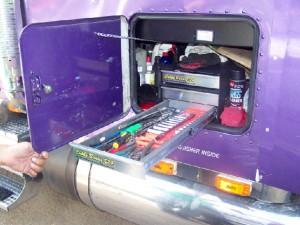 Driving a truck on rolling terrain takes skill. Unfortunately, too many of today’s drivers use their cruise control in times when they should not. These drivers need to shut their cruise control off and learn to drive their loaded truck like it was a roller coaster. When driving, especially when loaded, you always have to think about the “M” word, which is momentum. Using your cruise control will not allow you to pre-accelerate for the hills. Your brain should tell your right foot to start accelerating for an upcoming hill a quarter-mile before you actually get to it. Remember, this isn’t for a long climb up a mountain, this is for rolling hills and high bridge overpasses.
Driving a truck on rolling terrain takes skill. Unfortunately, too many of today’s drivers use their cruise control in times when they should not. These drivers need to shut their cruise control off and learn to drive their loaded truck like it was a roller coaster. When driving, especially when loaded, you always have to think about the “M” word, which is momentum. Using your cruise control will not allow you to pre-accelerate for the hills. Your brain should tell your right foot to start accelerating for an upcoming hill a quarter-mile before you actually get to it. Remember, this isn’t for a long climb up a mountain, this is for rolling hills and high bridge overpasses.
Momentum is important. If you are pushing a loaded wheel barrel and have to climb a 10’ high mountain, are you going to wait until you get there to accelerate? Not unless you want to make things hard on yourself. How about pedaling a bicycle with multiple gears, such as a mountain bike – don’t you always want to shift gears and get your momentum up before you get to the hill? Cruise control does not allow you to do this – it waits until the truck starts to slow down then it grabs the throttle. If you’re driving the hills properly, you will be able to use about 5 pounds less turbo boost, which saves you 100 horsepower (and gives you better fuel mileage).
Also, for those of you who have purchased a used fleet truck but refuse to spend $68 for a turbo boost gauge kit, you might be losing as much as half of a mpg, because it’s absolutely impossible to drive a turbocharged engine efficiently these days without a turbo boost gauge. I highly recommend that you get a turbo boost gauge and that you install it right up on top of the dashboard where your eyes are always seeing it – and then learn how to use it!
Has your DD5 Detroit engine been plagued with EGR valve, delta pressure sensor, EGR cooler and/or variable geometry turbo failures? How about excessive soot in the oil and the engine? If you’re patience is running thin with this engine, we may be able to help you. We have solutions for these engines, and the fuel mileage improvement will be at least 1 mile per gallon (that equates to a lot of saved money). You will have to bring your truck to our shop in Pennsylvania to have the new updated parts installed, but trust me, the trip will be well worth your time. This also holds true for the ISX Cummins EGR engines – if you are the lucky owner of one of these problematic engines, we can help you (and your engine), too.
 The Great American Trucking Show (GATS), held in Dallas, Texas at the end of August, was a smashing success! We always attend this show, and it is always a pleasure to be at that beautiful convention center and to experience (and appreciate) the politeness of the Texas-based owner-operators. Those of you who wear the double-starched jeans, cowboy shirts, cowboy hats, boots and the large belt buckles sure make a nice impression – and you’re positive attitude is good for the entire trucking industry. Thank you to all who came by our booth to chat about horsepower and efficiency.
The Great American Trucking Show (GATS), held in Dallas, Texas at the end of August, was a smashing success! We always attend this show, and it is always a pleasure to be at that beautiful convention center and to experience (and appreciate) the politeness of the Texas-based owner-operators. Those of you who wear the double-starched jeans, cowboy shirts, cowboy hats, boots and the large belt buckles sure make a nice impression – and you’re positive attitude is good for the entire trucking industry. Thank you to all who came by our booth to chat about horsepower and efficiency.
Have you heard of the Cubby Buddy? It’s a built-in tool box with sliding padded drawers made to fit in the side compartment of your bunk. If you carry tools in your truck, you’ll love this box – it’s like having a Snap-On tool box right in the side of your sleeper. The tools are kept organized, they don’t rattle, and the drawers will not slide out unless you give them a tug. This tool box was designed and built by Jeff Zehrer, an owner-operator, and you will really love it (see photo). For more information about this product, visit his website at www.16tonindustries.com or call (320) 352-6820.
Something to think about: an air bubble in the tip of an injector provides no fluid damping, allowing the injector plunger to impact the tip with up to 50% greater force, resulting in damage to the tip and the injector. Air can also cause the plunger to become seized or stuck. Normally, No. 2 diesel fuel contains about 10% airs in solution, although the air is not visible. Caterpillar recently released a special instruction about this topic, stating: “When the amount of dissolved air exceeds 10%, fuel rate and power output are reduced.” In our studies, and from feedback from owner-operators, we have concluded that even less than 10% of air in fuel still has a negative impact on an engine’s performance. This is why the FASS Fuel System, which removes the air from your fuel, will improve your engine’s performance by about 30 hp and allow the engine to run smoother and gain about .2 to .3 tenths mpg. Think about how many of your friends that have injector problems – do you think the air in the injector tip might be the problem?
Remember, with great power comes great responsibility, and power, properly used, makes good fuel mileage. If you have any comments or questions about any of these topics or others, I can be reached at Pittsburgh Power in Saxonburg, PA at (724) 360-4080 or via e-mail at bruce@pittsburghpower.com. Drive safe!
